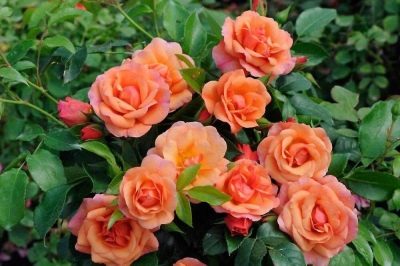
- Authors: Kordes
- Name synonyms: Aprikola, Rosa Aprikola, Summer Beauty, Apricot Vigorosa
- Breeding year: 2000
- Group: floribunda
- The main color of the flower: orange
- Flower size: medium
- Diameter, cm: 5-6
- Flower type by number of petals: terry
- Scent: fruity
- Description of the bush: vigorous, branched, spreading
Among apricot roses floribunda Apricola stands out not only for its delicate double flowers, but also for its harmonious development, lush greenery, and compact size of the bush. The variety is very popular in European countries, especially in the field of landscape design. Also this rose is known under the names Summer Beauty, Apricot Vigorosa.
Breeding history of the variety
The variety was introduced by the Kordes nursery from Germany in 2000. It is part of the Rigo-Roses series, which includes the fruits of 15 years of selection work. Roses from this line are marked with the ADR mark, which is awarded only to the most outstanding varieties.
Description of the variety
The bushes of the Apricola rose are vigorous, spreading, branchy. 70-80 cm high and up to 60 cm wide. Shoots are straight, medium-sized leaves on them, dark green, highly glossy. In inflorescences 4-5 buds are formed. The aroma of this rose is weak, fruity, with a pronounced sweetness.
The flowers are medium in size, with a basic orange color, the buds are goblet, salmon-amber, loose. Terry corolla, includes up to 40 petals. The blossoming flower changes color from golden apricot to light salmon.
Advantages and disadvantages
Roses of this variety do not fade in the sun and have very good rain resistance. The variety is considered universal for cultivation in different climatic zones, not too picky about the planting site. It feels good both in the sun and in the shade. The main advantage of Apricola is its delicate peach-apricot color of the petals, which attracts lovers of pastel roses.
The disadvantages of the plant are usually considered exactingness to watering and feeding. It is also worth considering that loose inflorescences quickly lose their petals; in a cut, a bouquet of such roses does not last long.
Flowering features
Rosa Apricola forms abundantly from June to September. Refers to multi-flowering varieties.
Use in landscape design
This variety of roses is suitable for growing in flower beds, as well as in group plantings of a cascade type. It can act as a background for other plants. Apricola looks interesting in the standard form, with lush flower hats over the graceful trunk.
Growing regions
The variety is suitable for planting in all regions of Russia.
Landing
For planting the Apricola rose, sunny or semi-shaded areas are suitable. The best soil will be one that is rich in organic matter, fertile, loose, with good drainage properties. The optimum planting density is 4-5 plants per 1 m2.
Growing and caring
Apricola is a rose that needs quite a lot of attention. It is responsive to fertilizing and watering and requires pruning during the entire growing season. With good care, the splendor and duration of flowering will fully correspond to the declared characteristics.
Watering and feeding
Irrigation of the soil under the Apricola rose is carried out every 3-4 days, with the introduction of 8-10 liters of water under each bush. Watering liquid is taken only warm, settled. The procedure is performed in the evening. Also, weekly foliar sprays are useful for the bush, protecting the flower from insects.
Top dressing affects all vegetative processes of the plant. They begin in the spring, they are carried out regularly, with an interval of 2 weeks. The optimal solution would be a combination of granular additives with liquid mineral complexes.Vitamin dressing is carried out superficially, along the sheet. Mulching the root zone with rotted manure mixed with garden soil has a beneficial effect on preparing the plant for winter.
Frost resistance and preparation for winter
This rose variety can withstand temperatures as low as -30 degrees Celsius. Only young bushes require shelter for the winter. Adults cut it off enough, sprinkle with a thick layer of mulch in the root zone.
Diseases and pests
The variety is very well protected against major crop diseases.
Review overview
Summer residents leave numerous reviews about the exceptional qualities of Apricola roses. Gardeners are pleased that the plant practically does not get sick, and the tough leaves are well resistant to insect attacks. Twigs that freeze in winter also quickly recover.
The flowering of this rose, according to reviews, in Russian conditions takes place in 2 main waves, and the second is always more abundant, lasts until early October. Up to 8 buds appear on the shoot, blooming alternately. The bushes are very elegant during the flowering period, they look spectacular. They look best at the budding stage and half-release.
Gardeners attribute the untidiness of the corollas to the small disadvantages of the Apricola roses. They lose their decorative effect after 2-3 days, but with timely removal, this does not spoil the overall impression. Also, gardeners mention a lower survival rate of seedlings during autumn planting. With an abundance of aphids on the site, the risk of the death of the rose increases; special attention must be paid to spraying from the pest.































































